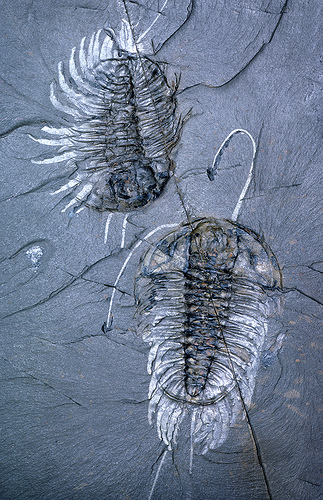The coordinates will take you to Emerald Lake where there is an information display on the Burgess Shale. It is wheelchair accessible. From there you can see the mountain side where the Burgess Shale fossil beds are located. The signs may be buried in snow in the winter.
The Burgess Shale occurs within the Stephen Formation in Burgess Pass on the southwest side of the saddle between Mount Wapta and Mount Field. At the time of deposition, this area was near the equator, and was the continental margin of North America. A 100m high near-vertical cliff of limestone occurred at the edge of the shelf. These rocks are known as the Cathedral Formation, and probably represent the escarpment of a large submarine slump (i.e. landslide) like those observed off the edge of carbonate platforms in areas like the Bahamas and Honduras today. The Burgess Shale was deposited at the base of this cliff, probably in anoxic conditions, as indicated by the lack of bioturbation (burrows, trackways, etc.) and the abundance of pyrite (often indicating the presence of H2S). All the organisms within the Burgess Shale have been transported to this location, probably by small mudflows that flowed over the edge of the cliff. This accounts for the variable orientation of the fossils and their superb preservation.

Burgess Shale was placed on the World Heritage list at the 1980 meeting of the UNESCO World Heritage Committee as a site of outstanding universal value forming part of the national heritage of mankind.
Dating from middle Cambrian time, more than 500 million years ago, it is one of the world's most significant fossil sites. It has yielded more than 150 species of some 120 genera. The remarkably preserved soft-bodied marine animals unique to Burgess Shale, are of major importance to evolutionary biology.
In 1909, while in Yoho conducting field work, Charles Walcott, renowned geologist and head of the Smithsonian Institution, found some unusual fossils in rock debris along the Burgess Highline Trail.
The following summer, Walcott found the main source of the fossils in a rock layer high above the trail. He spent five field seasons quarrying, and collected 65,000 specimens.
Walcott's find yielded a startling variety of exquisitely preserved soft-bodied marine animals. The Burgess Shale remains the world's most important Cambrian-aged fossil site, and continues to play a pivotal role in our understanding of the emergence of early animal life.
In 1930, a four man party from Harvard University, led by Percy Raymond, spent two weeks at the site, working Walcott's quarry and opening a second quarry twenty metres above.
After sitting dormant for many years, the Burgess Shale quarries were reopened by the Geological Survey of Canada (GSC) in 1966-67. Their work suggested the fossils were buried in front of an ancient underwater cliff - the Cathedral Escarpment.
Further study, spearheaded by Harry Whittington of Cambridge University, revealed that many Burgess Shale animals did not fit neatly into existing animal groups, as Walcott had thought. Some appeared to be biological oddballs belonging to extinct groups, suggesting a radical new view of animal evolution.
In 1975, Desmond Collins, of the Royal Ontario Museum (ROM), found unexpectedly large numbers of rare fossils in loose rock at the site. Inspired, he returned in 1981-1982 and, following the Cathedral Escarpment, found a dozen new Burgess Shale-type fossil sites.
Although not as rich as Walcott's find, fossils from these and other new sites around the world have shown that some Burgess Shale oddballs are, in fact, related to modern animals. What other secrets are waiting to be uncovered?
The Burgess Shale's designation as a UNESCO World Heritage Site reflects its global significance to science. In order to protect this priceless heritage, Parks Canada has restricted public access to the Burgess Shale. For up-to-date information on authorized guided hikes to the Burgess Shale, and where to see displays of the fossils, please check at the information centre in Field, BC.
Logging Requirements:
It is not necessary to take the guided hike to the fossil site in order to log this EarthCache. The display has photos of several of the fossils found in the Burgess Shale. To log a find for this EarthCache, send me an email with the name of three of these fossils and give their approximate length.
This cache was placed with permission from Parks Canada and complies with their geocaching guidelines found here.
| junglehair has earned GSA's highest level: |
 |
EarthCache Supporter
